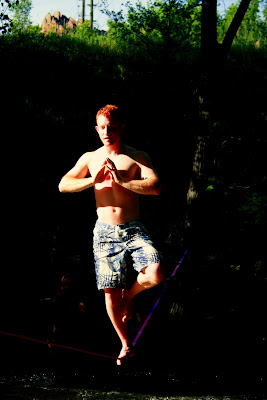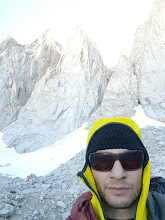
This man needs no introduction. His reputation precedes him. He is a pioneer in the slacklining community, not only building community but also pioneering new lines. He is the definition of a professional slackliner: sharing his passion with anyone even remotely interested, and constantly educating and advocating for slacklining access. Without further ado I present Scott Rogers.

me: So Scott, I understand you just took a trip to Mallorca, tell us a little bit about your trip, and what type of lines you set up
Scott: Yeah I just got back from a slack and relaxation trip in Mallorca. I rigged up some lines on the beach and taught little kids how to walk the line, and I also did the second walk of the arco natural in Cala Varques on the eastern coast of Mallorca
me: Tell us about your set up, I understand you had minimal amount of gear
Scott: Yes, very minimal. In order to reduce the weight of my gear (and consequently lower the airplane fees) I only rigged with a single threaded line. Usually we double up the lines to have sufficient backup in case of a line failure.
So it was a little unnerving, especially because I really didn't have the option of falling on to my leash (the high forces may have crushed the anchors), and the line was long enough to be close to the edge of my comfort level in highlining. So it was a little unnerving, especially because I really didn't have the option of falling on to my leash (the high forces may have crushed the anchors), and the line was long enough to be close to the edge of my comfort level in highlining.
The anchors themselves were really cool, there were natural holes in the rock that I threaded with slings and equalized to the master point on each side of the line. One of the holes was completely crushed when we took the line down and examined the anchors at the end of the day
me: Do you do any sort of training or preparation for highlining?
Scott: not anymore, no
they say the best training for doing something well is doing it

me: Why do you slackline/highline? What is the allure of this sport for you?
Scott: That's a good question. It seems like such a fruitless pursuit to an outside observer, but anyone who has actually stepped onto a line has felt the electrifying addiction that slackline has.
For me it is very meditative. So many people are searching for something, God, nirvana, happiness in general. For me, walking a high slackline is the easiest way to achieve this direct experience that so many are searching for. Step by step in the clouds, or next to a waterfall, or above an ocean. Each moment is limitless and the spirit is truly free. The possibility of achieving that moment is why I slackline.
me: Right now slacklining is a sport in its infancy. How do you feel about the importance of style and ethics (if any) in slacklining?
Scott: It reminds me a lot of skateboarding from back in the day. The most primitive tricks are currently being developed, jumps, spins, flips. One day people will look back and wonder why it took so long to learn all these tricks, but someone has to come up with them first. That is where the sport is currently (at least for the slacklining side)
For highlining, style is not so important. If you can get across, you're a badass. If you can get across without falling, even more so. But now people are throwing tricks on the highline as well. The more ambitious people get up high, the safer the systems need to be. The style is in the rigging systems. There are some really bright people out there innovating the rigging to make highlines safer and safer.
As far as ethics are concerned, that's a whole different debate. We're struggling to get slackline accepted and legalized in towns all over the country. Hopefully soon there will be a mutual respect between city officials and slackliners

me: What is the public image of slacklining, and will it positively or negatively affect access?
Scott: The public image for slacklining is pretty positive though, we're all good people and we all care for the well being of the environment and other people, so there shouldn't be too much resentment between us and the authorities. It isn't like we're all trying to "stick it to the man", we just want to be able to do what we love.
me: What kind of access issues are confronting slacklining right now? Do you see slacklining going the route of skateboarding in terms of illegality in public spaces? Will designated slackline parks be the future of slacklining?
Scott: Right now people are just starting to understand what slacklining is. In Boulder, for instance, there is a pre-existing ordinance saying that you can't attach anything to trees, and after years of slacklining in Boulder, they are only now starting to enforce it.
We're not sure which direction we'll have to go, but it involves two options I think, either making an exception to this ordinance for slacklining (using proper tree protection of course), or creating special use slackline areas in the parks.
me: What do you see in the future of slacklining? Where would you like to see it go?
Scott: It seems to keep growing and growing, with no end in sight. I think that is a good thing. The bigger slacklining gets, the more capable people will be of enjoying it. Right now it caters to a very small community of climbers, but it is recently expanding and now people are learning to slackline who have never climbed before in their lives. I hope it continues to grow to include more people in the sport.
me: What are your thoughts on the 2 inch vs 1 inch line debate?
Scott: 1 inch 4 life
me: Who are some slack liners who have influenced your development or who you look up to.
Scott: I take a lot of my style from Andy Lewis and Said Parirokh, and I also really look up to Dean Potter. Also the original Yosemite cats who got it all going.
me: What advice would you give to someone just starting to slackline?
Scott: It seems so difficult at first, especially highlining, but just practicing with a fun group of people will help you to grow in the sport, almost infinitely.
me: What's in your future? Do you have any big trips or plans coming up?
Scott: There are a couple big lines I'm planning for the Colorado area that I'll rig soon. I've also been practicing my BASE jumping so that I can start baselining soon. That seems like the ultimate crossover activity.
me: Any Shoutouts?
Scott: Slackline Brothers has always helped me out, and they have the best highline tensioning system in the world. Good people.
Also check out the Colorado Slackline Club, we're bringing slackline to Colorado in a big way, and helping people to learn to slackline and highline safely.
You can also check out Scott's blog at Scott's Mild Adventures for an introspective and intellectual perspective on his own life.







































